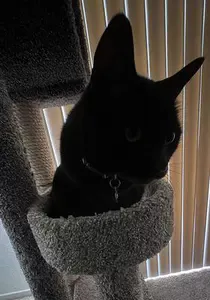The Beautiful Burmilla Cat
The Burmilla cat breed began in the UK in 1981 as an accidental mating between a silver male Chinchilla Persian and a female Burmese cat who belonged to breeder Baroness Miranda von Kirchberg.
They're known for their beautiful coats with a striking contrast between the light undercoat and tipped or shaded fur.
Their personalities are described as lively, friendly and affectionate, and they tend to be good with children and other pets.
In Federation Internationale Feline (FIFe), these cats are registered as Burmilla under the Shorthair category. In the Governing Council of the Cat Fancy (GCCF), they fall under the Asian group.
As of 2011, the Cat Fanciers' Association (CFA) recognizes both shorthair and longhair versions of the Burmilla cat. Other Cat Fancy associations recognized the breed as well.
The Burmilla cat was the second breed of the Asian Group created in the UK. (The Bombay first began with an American version in 1958, and later, a British version was created.)
The tale of the accidental mating that produced the original cats of this breed is now legendary. Like most of these tales of feline breeding lore, the story of the very first Burmilla cat has several versions.
Faberge, the female Burmese, is described as being of lilac color or platinum (Cats & Kittens, Barnes and Noble, 2004), although platinum in the Burmese is a Cat Fanciers' Association (CFA) designation, not a GCCF or FIFe one.
The Chinchilla Persian, named Sanquist, is sometimes reported to have been awaiting a mating partner. Therese Clarke tells a different story of the birth of the Burmilla breed, though, in that he was bought as a pet for von Kirchberg's husband. He simply hadn't been neutered yet.
As one version of the story goes, Faberge was put in the breeder's study while she went out. Sanquist was meowing outside the door and a member of the household was careless and let him in.
Not knowing what had taken place, the Baroness took Faberge to a Burmese stud for a mating. The cat became pregnant, but nine weeks later, she got a surprise. Instead of fully Burmese kittens, Faberge produced four female kittens of good Burmese (Asian) type and short, dense coats but with black-tipped silver fur.
It was apparently obvious who the father was, and Sanquist is reported to have been very protective toward the kittens, even helping to groom them (Encyclopedia of the Cat, Barnes and Noble, 2005).
It's said that the attractive appearance and excellent temperament of these unusual kittens won the favor of the Baroness. A breeding program was set up, and the new breed was called the Burmilla cat, after the names of both of their parents' breeds.
According to Clarke, the idea for the name came from "the two young men who used to look after the Astahazy cats" and not directly from the Baroness. Astahazy was von Kirchberg's line of cats.
A standard of points and breeding programs for Burmillas were accepted in 1983 by the Cat Association of Britain. They were officially recognized as a new breed by the GCCF in 1990.
The Burmilla cat has an agouti pattern, either standard or silver, shaded or tipped with color, but otherwise conforms to the Asian Shorthair standard. In some respects, this essentially makes it a Burmese cat with a fancy coat and green eyes, and there is a lot of breeding back to the Burmese in the breed.
But that's an oversimplification. They're described as a bit quieter than the Burmese, and less demanding. They do, however, retain the liveliness, intelligence, and affectionate and friendly nature of the Burmese.
Fans of the breed say they have endearing personalities, but the most unique and memorable feature of these cats, though, is clearly their beautiful fur coats. Specifically, the striking contrast in the silver undercoat and the shaded or tipped coat.
The undercoat is almost white in the silver, and should be as pale as possible in the standard coat.
The concentration of color is dense along the spine, and extends down the tail, gradually becoming lighter and as light as possible on the underside.
Shading may vary from tipping to medium-heavy shading, evenness and symmetry being more important than depth, provided a cat is not so lightly tipped that it appears white. A denser concentration of color should extend from the feet up the back of the leg to the hock.
Ideally, there should be no tabby markings on the body, but the forehead should be marked with an M and lines should be penciled on the cheeks and run from the outer edge of the eye, with the eye rim emphasized in the base color.
Paws should be lightly barred, and the tail marked with incomplete rings and a solid color tips. All the Burmese colors are accepted. The Burmilla shares the temperament of the other Asian Shorthairs.
You might be asking, what about the long haired version of the Burmilla cat that I've seen in pictures and videos? Well, there is a gene for a longer coat and a long haired version of this breed does exist.
It's classed as the Tiffanie in the UK (British origin, falling under the Asian Group, arising from the Burmilla). Sometimes the Australian Tiffanie is said to be the same cat, from the same lines.
But, while they may have begun with the same stock, the Australian Tiffanie lines actually have been bred separately and are considered a different breed.
They have a different breed standard, and they lean toward more Persian features, looking much more like the Chinchilla. The coat is more like the Persian cat as well.
There is also an American cat known as the Tiffany (also called Chantilly) thought at one point to have come from naturally occurring long haired cats in the Burmese lines. That would make it a true longhair version of the Burmese. But, there is some confusion as to the origin of these cats.
The CFA now recognizes both a shorthair and longhair Burmilla cat breed in the Miscellaneous category, and the breed standard calls for a pure white undercoat in all the tipped and shaded varieties.
These cats have a dense coat, but are much easier to care for than the Persian. Using a rubber brush first to loosen dead hairs followed by a good combing at least once a weak is recommended.
Despite the proliferation of videos and pictures on the Internet, these are one of the more rare cat breeds, with only 380 registrations in 2009 for the entire Asian Group in GCCF.


Comments: What do you think?
Have your say about what you just read. Leave me a comment in the box below.